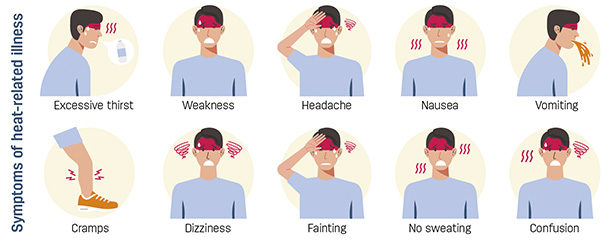Even in Canada, we can get a few weeks of hot, intense summer weather. Working in the heat, both indoors and outside, can result in illness due to heat and sun exposure.
In addition to the direct consequences such as sunburn and heat stroke, working in the heat and direct sun can cause incidents due to loss of focus or excessive fatigue on the job.
Before working outdoors, check the weather forecast and UV index. Plan strenuous work to be completed in the early morning or late afternoon to avoid outdoor work when it is very hot and/or humid. Avoid unnecessary exposure to the sun, especially between 11 a.m. and 3 p.m., as that is when it is most intense.
To protect your skin from the sun, use sunscreen and reapply every two hours. When possible, wear a hat and light-coloured clothing to cover exposed skin (such as arms and legs). Keep in mind that tans and sunburns are signs the UV rays have already damaged the skin. Use shaded structures – umbrellas, buildings or trees – to provide shade. Encourage breaks in shaded or cool areas so workers can cool down.
Drinking and eating
Drink plenty of water during strenuous activities, especially in hot environments. When working in the heat, drink 8 ounces (1 cup) of water every 15 to 20 minutes. This translates to 24 to 32 ounces (3 to 4 cups) per hour. Liquids containing sugar and caffeine will dehydrate you, so when working in the heat, try to stick to water and electrolyte replacement drinks.
Ensure you eat regular meals as well. Food replaces electrolytes lost in sweat, especially in the extreme heat, when you lose the most salt in sweat. Try to eat smaller meals and snacks throughout the day to give your body the energy it needs to perform your job.
Acclimatization
Allow for acclimatization to a hot environment before any strenuous work begins. The best way to acclimatize yourself to the heat is to increase the workload performed in a hot setting gradually over a period of one to two weeks. Pushing to the point of heat exhaustion will hurt, not help, your heat tolerance. Remember to also note the humidity/ humidex in the day because it can greatly impact your ability to work outside in the heat.
Symptoms of heat stress
Heat cramps are painful, brief muscle cramps. Muscles may spasm or jerk involuntarily. These can occur during exercise or work in a hot environment or begin a few hours later. Heat cramps occur because of loss of nutrients from sweating and dehydration. Ensure you are getting the proper water and food intake throughout the day to prevent heat cramps.
There are two types of heat exhaustion. The first is water depletion; signs include excessive thirst, weakness and headache. The other is salt depletion; signs of this include nausea, vomiting, muscle cramps and dizziness.
If anyone is having symptoms of a heat-related illness, get them medical attention before the problem turns into heat stroke. For people displaying symptoms of heat exhaustion, have them stop work and get to a shaded area. The affected person needs to consume water or electrolyte-replacing sports drinks.
Heat stroke
Heat stroke is the most serious heat-related illness. Heat stroke can kill or cause damage to the brain and other internal organs. Heat stroke results from prolonged exposure to high temperatures, usually in combination with dehydration, which leads to failure of the body’s temperature control system. Symptoms of heat stroke include fainting, throbbing headache, dizziness, lack of sweating, vomiting or behavioral changes such as confusion.
Anyone who is displaying symptoms of a heat stroke needs immediate medical attention. The person should be cooled down immediately in a shaded area or indoors. Do not put ice cold water on the victim, as this can cause shock. Use cool water to lower the body temperature of the victim. Remove any unnecessary clothing and fan the victim until they can be transported to the hospital.
TAKE HEAT STRESS SERIOUSLY
- Take precautions to keep employees cool and protected from the sun, as well as hydrated.
- Schedule in more frequent breaks to accommodate for hot weather.
- Schedule jobs around sun and heat exposure as best as possible.
- Know the signs and symptoms of heat stress.
- Have a plan to get the proper medical attention for any individual displaying symptoms of heat stress.










